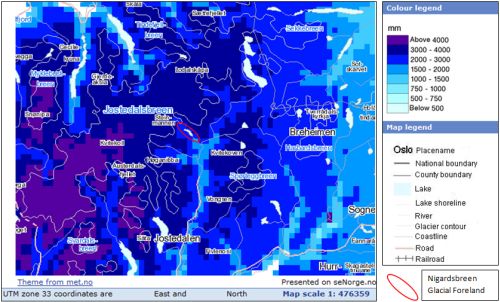An Investigation into Lichen Growth on Terminal Moraines on the Glacial Foreland of Nigardsbreen, South Norway
Dee Johnson[1], Department of Geography and Development Studies, University of Chester
Abstract
Lichens are a symbiosis of two organisms, algae and fungi, which colonise exposed surfaces and can be measured to date the approximate age of the surface. The study of lichens is therefore important to help establish a timescale of events. It is generally believed that the larger the lichen, the longer it has colonised the surface, and therefore that larger lichen means an older surface. However, researchers have found a 'Green Zone' and the hypothesis suggests that lichens are larger at the proximal (side of the moraine closest to the glacier) base of terminal moraines (ridge of sediment that is deposited when a glacier retreats) than at other locations (Haines-Young, 1983). This hypothesis is tested by data which was collected from six dated moraines on the glacial foreland of Nigardsbreen in the Jostedal, Norway. Five transects were taken across each moraine, each consisting of 3 metre x 3 metre quadrats where the five largest lichens were measured (Innes, 1984: 343). In addition to measuring the lichen thalli diameters, 3 other factors were also measured: aspect, gradient and vegetation cover. These factors are important to determine why the largest lichens are found in a particular location, whether it supports the hypothesis or not. If the data collected from Nigardsbreen supports the 'Green Zone' hypothesis, there are implications for using lichens to date surfaces of unknown age.
Keywords: Lichenometry, Nigardsbreen, Rhizocarpon geographicum, 'Green Zone', slope aspect, slope gradient
Introduction
The purpose of this investigation is to measure diameters of the lichen Rhizocarpon geographicum on proximal, crest and distal (side of the moraine furthest from the glacier) slopes on terminal moraines on a glacial foreland. This is to determine if the size of the lichen varies across the moraine and to identify any influencing factors which may be contributing to a size variation. This study develops that started by Haines-Young (1983) who observed larger lichens on the proximal slope of moraines when compared to the crest, which he termed the 'Green Zone'. This could be anomalous; however, if the 'Green Zone' does exist there are implications for the reliability of previous studies as they could conclude that substrates are older because the lichen sizes are larger. This relationship between the size of the lichen thallus and the age of the exposed material is the main principle of lichenometry, which was first introduced by Beschel in the 1950s. The field area chosen to carry out this investigation is the glacial foreland of Nigardsbreen, southern Norway, which is an outlet extending from Europe's largest ice cap, the Josedalsbreen. Extensive research has been undertaken in the Jostedalen region on the terminal moraines on the forelands of the glaciers which extend from the Jostedalsbreen ice cap. Both direct and indirect lichenometric approaches have been used in an attempt to date the moraines by creating dating curves (through the indirect method) and lichen growth curves (through the direct method). Rhizocarpon geographicum have a growth which after a sharp exponential increase becomes more uniform over time (Armstrong, 2004: 35 and Purvis, 2000: 19) and therefore could mislead the age of the substrate, as the diameter of a thallus after 10 years, for example, could remain the same thereafter. The lichen growth curves, and also the dating curves to some extent, assume that the environmental conditions have remained the same through time without fluctuation. Some research has been completed to understand the influence of water (Gregory, 1976; Andrews and Webber, 1964; Curry, 1969 and Harvey et al, 1984), snow patches (Carroll, 1974 and Benedict, 1993) and aspect (Armstrong, 2002) on the growth of lichens, but this is only a small number. If lichens are to be used successfully as a dating tool then the factors which hinder or promote growth need to be understood or data may be unreliable.
Lichen Growth on a Glacial Foreland
Lichenometry
Lichenometry is a dating technique which fairly accurately identifies the age of a deposited surface by measuring the thalli of lichens, which are a symbiosis of two organisms, fungi and algae (Armstrong, 2004). Lichenometry has been widely adopted on surfaces presumed to be younger than 500 years, where radiocarbon dating is ineffective (Jones and Keen, 1993). Examples of applications are: debris flows (Innes, 1985; Rapp and Nyberg, 1981), river floods (Gregory, 1976) and raised beaches (Birkenmajer, 1981). Early colonisers of bare rock surfaces and slow growth rates (Haines-Young, 1983) are the two primary reasons why species from the Rhizocarpon genus are used, and most commonly the yellow-green Rhizocarpon geographicum subgenus which are crustose lichens and have a slow and apparently regular growth rate (Mottershead and White, 1972).
Direct and Indirect Approach
Extensive research has been carried out involving the Rhizocarpon lichens, by measuring the radial growth directly (Trenbirth and Matthews, 2010; Cook-Talbot, 1991) over a period of time, or indirectly (Matthews, 1994; Bickerton and Matthews, 1993; Haines-Young, 1983) by measuring the thalli of lichens on a surface of known age (Armstrong, 2004). The indirect approach is usually more reliable as it relates to growth over a longer period than that of direct study (Armstrong, 2004); however, it still makes assumptions which may affect the results of a study. Firstly, the indirect approach assumes that the largest lichens present are the same age as the substrate; secondly, the indirect approach also assumes that recolonization has not occurred after a destructive event, such as floods, snow kill (Carroll, 1974) and animal dung (Osborn and Taylor, 1975), and would make the lichens younger than the substrate (Mottershead, 1980). Thirdly, the method also assumes that the Rhizocarpon geographicum colonizes the bare surface immediately when many studies have found different lag times in colonization (Andre, 1986: 67, Matthews, 1974: 219 and Innes, 1982).
Lichen Growth Curves and Dating Curves
Lichenometric dating curves have been produced by numerous researchers (Bickerton and Matthews, 1992; Erikstad and Sollid, 1986; Mottershead and White, 1972) and relate the size of the largest lichens in a population to a surface of known age (Loso and Doak, 2006) to enable a surface of unknown age to be approximately dated. These dates can vary, however, some by 28 years and others by 15-25 years (Matthews, 1994), which highlights the inaccuracy of the technique. Erikstad and Sollid (1986) produced a 'Western Curve' (Matthews, 1994) which is an example of a regional dating curve, using fixed points from four glacial forelands across southern Norway. This technique however, can be less reliable than local lichenometric dating curves due to ' environmental heterogeneity' (Matthews, 1994: 195).
Beschel was the first to develop growth curves for the Rhizocarpon geographicum, which grows around 0.5mm/year; however, this rate does vary with age as the younger thalli grow the fastest and the older thalli grow more slowly (Purvis, 2000: 19). This decline in growth as the lichen becomes older is illustrated in many growth curves (Armstrong, 2004), and supports the trend found on dating curves which shows lichen size becoming uniform after rapid growth, perhaps as a result of the growth rate declining. This similar trend suggests that both methods of dating are reliable; however the indirect method to produce dating curves may be more widely adopted as it requires less time measuring lichens in the field.
Factors Affecting Lichen Growth
The environmental influence on lichen growth is complex as differences in variables such as slope, aspect, exposure and moisture availability can affect growth (Worsley, 1990).
Moraine characteristics
The gradient of the proximal and distal slope is also a factor that can affect the size of lichen diameter. Mahaney and Spence (1985: 211) stated that moraine slopes with a gradient of more than 10° are rarely stable and are prone to movement such as debris sliding, solifluction and creep; therefore growth could be stopped if the material moves and comes to rest upside down (Beschel, 1973). As a result lichens which colonize the recently exposed rock would not reflect the true age of the moraine.
It has been suggested by Armstrong (2002) that the aspect of rock surfaces may affect the growth of the lichen Rhizocarpon geographicum; his results from Gwynedd, North Wales, showed that the radial growth of the thalli on the north-west facing slopes was 'significantly greater' than that on the south-east facing slopes (Armstrong, 2002: 193). This difference could be a result of the north-west facing slopes retaining moisture longer, which Curry (1969) suggests encourages growth, because the slopes are not exposed to direct sunlight. The south-east facing slopes, however, are exposed to sunlight for longer; therefore they become drier and retain less moisture which may reduce lichen growth.
The 'Green Zone'
Location on the moraine has been suggested by Matthews (1977) as a variable that affects the size of the lichen when research was carried out on the oldest moraines at Storbreen, Norway. It was observed that the larger thalli appeared to be at the proximal base of the moraine, known as the 'Green Zone', which Haines-Young later went on to study (1983). Haines-Young's results which were collected from the forelands of Storbreen and Nigardsbreen also found larger thalli measurements on the lower part of the proximal slopes. The lower part of distal slopes were not measured to determine if the 'Green Zone' exists on both sides of a moraine and this along with other points was critiqued by Mahaney and Spence (1985).
Aims
The aims of this study are:
-
To compare lichen growth on proximal, distal and crest positions on moraines within a glacial foreland in Norway.
-
To test Haines-Young's (1983) hypothesis regarding the presence of a 'Green Zone' which has optimal conditions for lichen growth on the proximal slopes of moraines in Norway.
-
To test whether Haines-Young's (1983) 'Green Zone' is present on distal slopes.
-
To relate the lichen growth observations to possible influencing factors such as moraine age, slope position, slope aspect and slope gradient.
These aims will be explored with reference to the glacial foreland of Nigardsbreen, southern Norway (see Figure 1).
Hypothesis
Haines-Young's 'Green Zone' does exist on the terminal moraines which were measured between 15 June 2010 and 21 June 2010 on the glacial foreland at Nigardsbreen.
Null Hypothesis
Haines-Young's 'Green Zone' does not exist on any of the terminal moraines measured between 15 June 2010 and 21 June 2010 on the glacial foreland at Nigardsbreen.
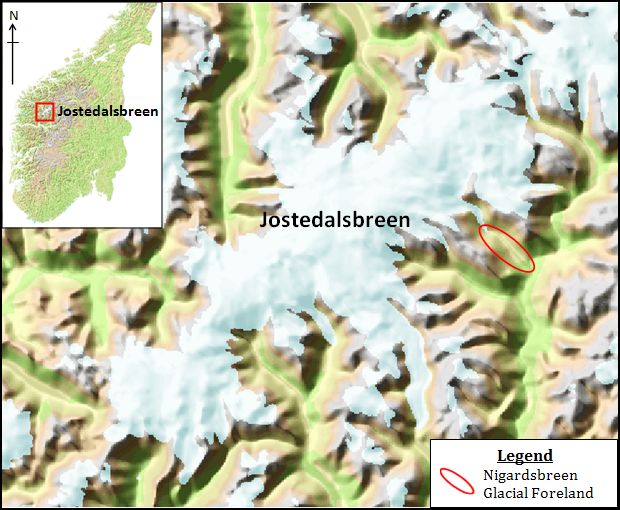
Figure 1: Location map of the Jostedalsbreen ice cap in southern Norway and the location of the study site Nigardsbreen. [Source: seNorge.no; Map Scale 1: 370,501; UTM zone 33 coordinates are 89566 East and 6844189 North]
Study Site
The Glacial Foreland of Nigardsbreen
Nigardsbreen is one of many outlet glaciers, extending from Europe's largest continental ice cap the Jostedalsbreen in Norway (Nesje and Dahl, 1993: 259). Historical documents which tell of farms being destroyed by a glacial advance, combined with lichenometry, imply that Nigardsbreen reached its glacial maximum during the mid-eighteenth century (Nesje and Dahl, 1993: 259); a period in the Holocene known as the 'Little Ice Age'. Since this maximum the glacier has retreated approximately 4km, with intermittent advances which formed a sequence of terminal moraines along the foreland (Bogen, 1989: 113) and a glacial lake which is nearly 2km in length (Bickerton and Matthews, 1992: 228). The terminal moraines, many of which are 2-5m in height (Bickerton and Matthews, 1992: 228) and span the width of the foreland, are composed of granitic gneiss. After the glacier retreated it took some years before plants established themselves, and the first to do so were lichens, known as the pioneer community in the succession. Slowly over time the succession led from lichens to coniferous woodland (Betula pubescens). As a consequence the vegetation along the foreland towards the glacier represents approximately 250 years of botanic development; older vegetation to younger vegetation closer to the glacier.
Methodology
The aims were addressed by collecting both qualitative and quantitative data from six terminal moraines on the glacial foreland in front of the valley glacier Nigardsbreen.
Lichen selection
When measuring lichens it is important to select a species which is abundant within the site, to be able to collect sufficient data (Mottershead, 1980: 97), which is why the Rhizocarpon geographicum or 'map' lichen was selected at the site of Nigardsbreen. Another deciding factor was that it is easily distinguishable on a rock surface, with a clear thallus, making it easy to measure its correct dimensions.
Sampling method
Researchers have previously employed one of three main methods of sampling lichens:
- Find the single largest lichen (Webber and Andrews, 1973; Miller, 1973)
- Find several (usually 5 or 10) largest lichens and take an average (Innes, 1984; Andre, 1986; Sjoberg, 1990; Mottershead and White, 1972; Matthews, 1974, 1975)
- Find the average of a random sample of the lichen population (Pitman, 1973).
The method of finding several largest lichens and taking the average was used because there has been discussion into the deficiency of the other two sampling methods (Innes, 1984; Matthews, 1973; Griffey, 1978).
Sample Point
Six previously dated terminal moraines (1750, 1790, 1840, 1850, 1860, and 1875) (see Figure 2) were selected along the glacial foreland at Nigardsbreen for measurements to be taken from. Previously dated moraines were selected because they were the most defined on the foreland and larger than the other undated moraines. This selection was important because each moraine had a clearly defined proximal, distal and crest position which could be measured. It was also beneficial to sample dated moraines because it would be expected that lichen size increases with the age of the moraine because the oldest has been exposed for a longer period. If this expectation is not found, it will support the concept that other factors influence lichen growth.
Five three-metre-wide transects were taken across each moraine, with a space of two metres in between; each transect contained five quadrats within. Lichen thalli were measured in each quadrat and the five largest that were found were recorded.
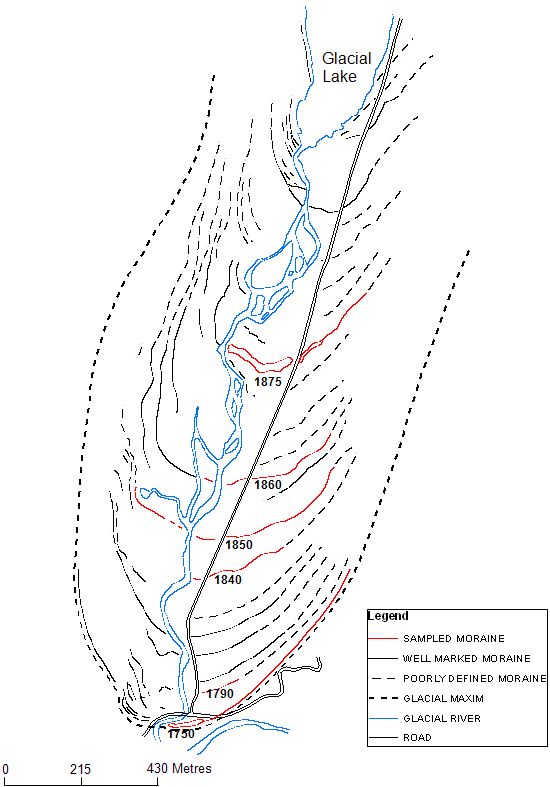
Figure 2: Map of the Nigardsbreen glacial foreland indicating moraines that were sampled. [Source: Adapted from Bickerton and Matthews, 1992.]
Measurements
The lichens were measured using a pair of Vernier Calipiers (see Plate 1) which are a 'precision instrument' and can be used to measure accurately internal and external distances (Ryan, 2004).
The lichen thalli can be measured in two ways:
- using the longest axis (Anderson and Sollid, 1971, Bickerton and Matthews, 1992),
- using the mean of the shortest and the longest axis (Erikstad and Sollid, 1986).
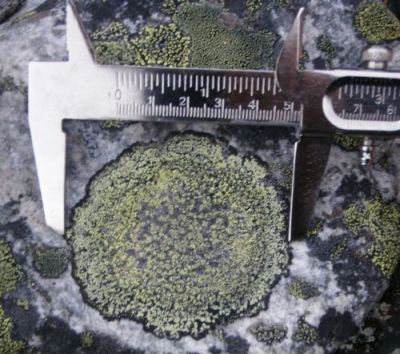
Plate 1: Using Vernier Calipiers to measure the longest axis of a Rhizocarpon geographicum lichen. [Source: Author's own collection, 2010.]
In this study the longest axis of the lichen was measured as it would represent unrestricted growth (Innes, 1986: 3) and therefore its diameter would be determined by factors other than competition for space on the material between lichens. Slope gradient and aspect were also measured within each quadrat using a compass clinometer and recorded. When analysing the data these other variables may have significant relationships to the size of the lichens, which is important if the growth of lichens on the moraines is to be better understood.
Data Analysis
The data recorded on the glacial foreland were analysed by looking at both descriptive and statistical results. The descriptive results highlighted general trends by presenting the data in chart form which then informed the statistical analysis; achieved using a Statistical Package for the Social Sciences (SPSS), to explore whether the results were significant or not. An 'Independent Samples T Test' was applied to establish if lichen diameters compared in two positions on each moraine were significant or not. However when undergoing the results it was found that the data did not meet one out of the three assumptions of the test:
The dependent variable is normally distributed (see Appendix B for an example of Q-Q plots and a histogram which don't have a normal distribution).
The Mann-Whitney U test was therefore applied because no assumptions had to be met. The results were very similar to those from the 'Independent Samples T Test'; however they are now reliable because no assumptions need to be met.
Results
Comparing Lichen Growth on Proximal, Distal and Crest Locations
The lichen size data were inputted into Microsoft Excel to create bar graphs with the aim of identifying general trends within the data. The proximal and distal data were combined and represented using bar graphs to determine whether any general trends could be observed (see Figure 3a-f).
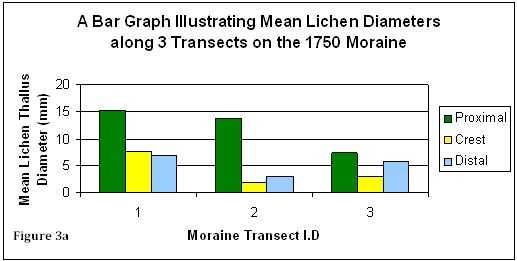
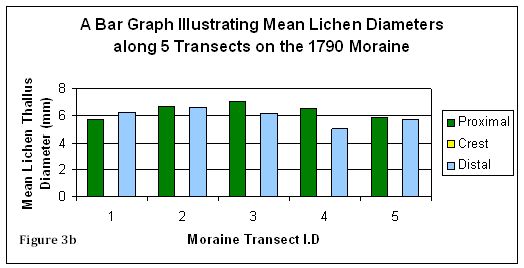
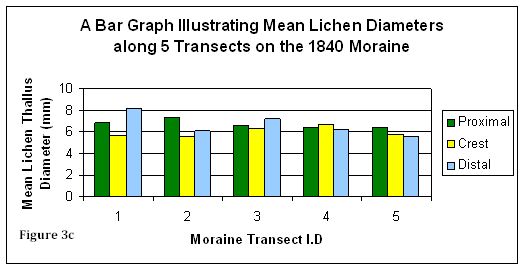
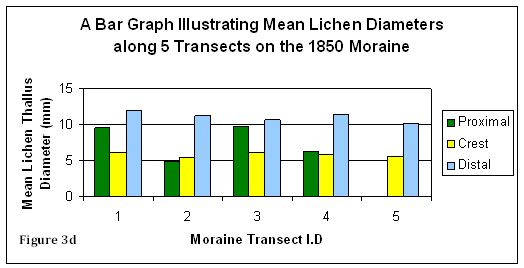
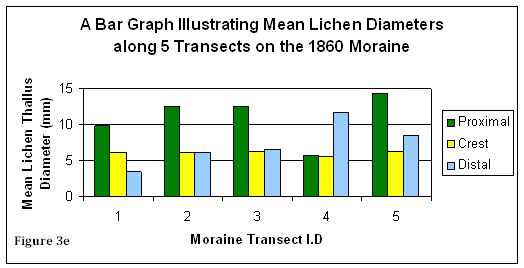
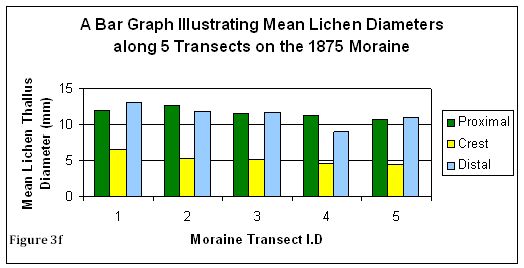
Figures 3a-f: Bar graphs that illustrate the mean lichen diameters across the six moraines that were sampled.
The general observations which were made from the combined bar graphs were:
-
Lichen diameters on proximal slopes are generally larger than those on distal slopes,
-
Crest measurements are smaller than the proximal and distal slope measurements.
There is, however, a noticeable exception to the first observation as the 1850 moraine has larger lichens on the distal slope when compared to the proximal slope, which suggests a factor may have influenced this difference.
The general observations, however, do not quantify the difference which was observed on the bar graphs. Therefore the mean lichen diameters of proximal, distal and crest quadrats on all six moraines were calculated into percentages (see Table 1) to quantify how many quadrats on one location had larger lichens when compared to another location.
| Relationship of Mean Lichen Diameters (cm) | Percentage (%) |
|---|---|
| Proximal Slope > Distal Slope | 57% |
| Distal Slope > Proximal Slope | 43% |
| Crest > Proximal Slope | 9% |
| Crest > Distal Slope | 17% |
| Proximal Slope > Crest | 91% |
| Distal Slope > Crest | 83% |
Table 1: Size relationships between proximal, distal and crest locations on six moraines.
The general observation:
-
Lichen diameters on proximal slopes are larger than those on distal slopes,
is confirmed by the percentages in the table. 57% of transects have larger lichens on the proximal slope, compared to 43% of transects which have larger lichens on the distal slope. This is a 14% difference which is not as large as was expected but will be statistically tested to determine if there is a significant difference between lichen size on the proximal and distal slopes.
The general observation:
-
Crest measurements are smaller than the proximal and distal slope measurements,
is also confirmed by the percentages in the tables. The percentage of transects with larger crest values than proximal slopes was 9%, whereas the number of transects with larger proximal slope values than crest values was 91%. This highlights a much larger difference and suggests that lichen diameters on proximal slopes are larger than lichen diameters on the crest in the vast majority of cases. The same relationship was found when comparing distal measurements to crest measurements; 83% of transects had larger lichen measurement on distal slopes, whereas only 17% had larger lichen measurements on the crest. It would therefore be worthwhile to see if there is statistically a significant relationship between the moraine slopes and the crest.
Statistically Analysing Lichen Growth on Proximal and Distal Moraine Slopes
To test whether the general relationships found were significant or not they were converted into hypotheses:
-
Lichen diameters are larger on the proximal slopes than those on the distal slopes.
-
Lichen diameters are larger on the moraine slopes than on the moraine crest.
These were tested by inputting the lichen size data into SPSS and applying the Mann-Whitney U test.
| Relationship | Difference | Significance Value |
|---|---|---|
| Proximal Slope – Distal Slope | Significant | .000 |
| Proximal Slope - Crest | Significant | .002 |
| Distal Slope - Crest | Not Significant | .305 |
Table 2: Significance of each of the 3 relationships analysed using the Mann-Whitney U test in SPSS on lichen diameter.
The summary table (see Table 2) of the results with a 95% confidence level from SPSS shows that:
The lichen diameters on the proximal slopes compared to the distal slopes are significantly different; therefore the first hypothesis can be accepted.
The lichen diameters on the proximal slope compared to the crest are significant; however the lichen diameters on the distal slope compared to the crest are not significantly different, therefore the second hypothesis cannot be accepted or rejected.
Influencing Factors on Proximal, Distal and Crest Locations on Moraines
Slope Aspect
As Armstrong (2002) inferred, aspect can have an effect upon lichen growth therefore the aspect of every quadrat was plotted on a radar chart (see Figure 4) to illustrate the dominant aspect of the proximal and distal slopes measured. This may help to determine why lichen diameters are generally larger on the proximal slopes rather than the distal slopes.
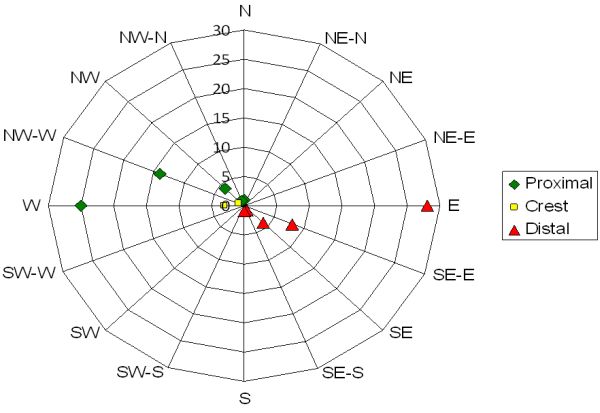
Figure 4: A radar chart which illustrates the aspect of quadrats that were measured on distal, proximal and crest locations.
General observations from the radar chart are:
-
Proximal slopes are westerly to north-westerly facing
-
Distal slopes are easterly to south-easterly facing
Slope Gradient
If a slope has a gradient greater than 10° it can affect the stability of the moraine (Mahaney and Spence, 1985: 211) and consequently the growth of the lichens. The average slope gradient for the proximal and distal slopes was calculated (see Table 3) to determine if they are greater than 10° and therefore possibly unstable.
| Location on Moraine | Average Gradient (°) |
|---|---|
| Proximal Slope | 28° |
| Distal Slope | 32° |
Table 3: Average slope gradient of the proximal and distal slopes.
General observations from the table are:
-
Both proximal and distal slopes have an average slope gradient greater than 10°
-
The average distal slope gradient is 4° steeper than the average proximal slope gradients.
Discussion
Lichens on the proximal and distal slopes
The research carried out by Haines-Young (1983) found that lichen diameters on the proximal slopes of moraines were much larger than anywhere else on the moraine, which he termed the 'Green Zone'; however the distal slopes were not measured in his study. This was critiqued by Mahaney and Spence (1985); therefore when testing Haines-Young's (1983) hypothesis of a 'Green Zone' existing on moraine slopes the measuring of distal slopes was necessary to develop upon Haines-Young's (1983) research method. The results, after measuring the proximal and distal slopes of terminal moraines on the glacial foreland of Nigardsbreen, highlighted that the proximal slopes had larger lichens than distal slopes and after statistically analysing the data this observation was found to be significant (see Table 2). When comparing the proximal measurements to the distal measurements it was found that only the 1850 moraine had larger distal values than the proximal; an anomaly in the data that will be discussed further. The general results corroborate and support Haines-Young's conclusion that a ' Green Zone' exists on the proximal slopes on moraines in Norway. Haines-Young (1983) however, did not examine possible factors that may influence this difference in growth, therefore in this study some of these factors were measured. If these factors coincide with a difference in lichen size then there is a possibility that when using lichens to date substrates the approximated age may be incorrect. This would have implications for dating curves that have been developed by previous researchers, such as Bickerton and Matthews (1992); therefore this study is important to recognise the influencing factors of lichen growth so future age approximations can include these factors.
Slope Aspect
The terminal moraines on the foreland of Nigardsbreen extend from one side of the U-shaped valley to the other and therefore the aspect of both the proximal and distal slopes vary on the same moraine ridge. To overcome this, the aspect was measured in each quadrat and found that proximal slopes are westerly to north-westerly facing and distal slopes are easterly to south-easterly facing (see Figure 5). A study undertaken by Armstrong (2002) in Gwynedd, North Wales, found that the size of Rhizocarpon geographicum on north-west facing slopes was much larger than those found on south-east facing slopes. This relationship between aspect and the size of the lichen was found on the moraines measured at Nigardsbreen as the proximal slopes had larger lichens than the distal slopes, except for the 1850 moraine. This anomaly cannot be explained when considering aspect as the influencing factor because both the proximal and the distal slope have the same aspect as other proximal and distal slopes measured on the other moraines. Therefore another factor must have influenced this one anomaly which will be discussed further. The results found on the other terminal moraines in Nigardsbreen may be similar to those found by Armstrong (2002) in Gwynedd, North Wales because it has a similar maritime climate; receiving 600mm-2200mm annual rainfall (1971-2000) (Met Office, n.d.) and average mean temperatures (1971-2000) ranging from 3.5°C – 7.5°C (Met Office, n.d.). The aspect of the rock surface could be sheltering the Rhizocarpon geographicum from the similar climatic conditions as north-westerly facing aspects do not receive as much direct sunlight and therefore retain moisture which helps the algae component of the lichen to photosynthesise and grow. South-easterly facing aspects however do receive more direct sunlight and as a consequence lose more moisture.
Slope Gradient
The processes that occur on a slope with a gradient more than 10° include solifluction, creep, debris sliding and earth slumping according to Mahoney and Spence (1985) and therefore make the slope unstable. This formed part of the critique regarding Haines-Young's work in 1983 as he assumed the moraine slopes were stable. The results from the moraines at Nigardsbreen found that the average proximal slope was 28° and the average distal slope was 32° (see Table 3), which are both much steeper than 10° and suggests that areas on both slopes are potentially unstable. A study by Beschel (1973) suggests that material which is disturbed and comes to rest upside down can kill the lichens which first colonized the substrate. As a result when new lichens colonize, the moved substrate has the potential to be dated too young because the lichens will not have had time to grow and will therefore be smaller. The average gradient of the moraine slopes measured at Nigardsbreen are both greater than 10° and therefore may be subject to movement, by physical processes and also by humans or animals traversing the moraines and consequently the lichens which are on top may not be the original colonizers. During the data collection it was recognized, particularly on the younger moraines which were measured, that the material was loose and unconsolidated on the proximal and distal slopes and very easy to dislodge (see Plate 2). The results show that the average distal slope gradient is 4° steeper than the average proximal slope gradient and therefore may be more unstable. This would result in smaller lichens on the distal slope than on the proximal slope, which the results from SPSS (see Table 4) illustrate as the lichens are significantly different when comparing the proximal to the distal moraine locations. Therefore this would suggest that slope gradient does have an effect upon the size of the lichen. The only anomalous moraine that was found to have lichen diameters larger on the distal slope rather than the proximal slope was the moraine dated 1850. The average proximal gradient on this moraine is 23° compared to the average distal gradient which is 21°. Both are still over 10° and are therefore potentially unstable, however the steeper proximal slope could be influencing the smaller lichen sizes on the proximal slope when compared to the distal slope on this one moraine which does not follow the general trend.
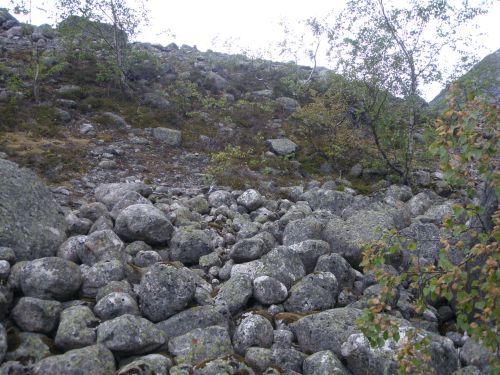
Plate 2: Unconsolidated boulders on the proximal slope of the 1875 moraine. [Source: Author's own collection, 2010]
Lichens on the proximal slopes and the moraine crest
The crests of the moraines were approximately 2-5m (Bickerton and Matthews, 1992: 228) above the foreland; therefore are more exposed to rainfall, wind and direct sunlight than the moraine slopes. Many of the crests had a level gradient which could become prone to accumulating water in heavy rainfall as the foreland experiences 1500mm-3000mm of rainfall annually (see Appendix A) (seNorge.no, 2011). Lichen growth on this position of the moraine could be stunted as a result of too much water, which was found similarly in Australia (Gregory, 1976) and Canada (Andrews and Webber, 1964). When collecting the data from the moraines on the foreland some of the crests seemed to have been walked on by tourists as the glacial foreland is a National Park. Lichens are not obstructive organisms therefore can be easily trampled by walkers who are not aware of them and as a result have the potential to damage the lichens. This is therefore another factor that may contribute to lichen sizes being smaller on the crest than on the proximal slope. As the highest point on the moraine the crest will receive the most direct sunlight which means the lichens growing on that position will lose the moisture received from morning dew or mist quicker than on the slopes and therefore could be slowing the growth. This is because lichens need some moisture for the algae component of the symbiosis to photosynthesise (Lange, Kilian and Ziegler, 1986: 104), which provides energy; therefore if the moisture evaporates quickly, the lichen has a limited time to photosynthesise. The conclusion that lichens are larger on the proximal slope than the crest substantiates Haines-Young's 'Green Zone' hypothesis and this section of the discussion will look at the factors which may influence growth at this location on the slope rather than on the crest.
Slope Aspect
As previously stated, the aspect of the proximal slopes that were measured was found to be westerly to north-westerly facing and this coincided with the location on the moraine with the largest lichens. The crests however had the smallest lichens and generally had no aspect as they were all relatively flat. This pattern was expected to be found because of the climatic influence on the lichens on the crest, whereas the slope is more protected. On the crest the lichens are more exposed to direct sunlight and precipitation, as well as being more capable of retaining water and snow because they were all generally flat. Snow in Colorado, USA was found to have killed lichens in 90% of a study area (Benedict, 1993: 29), during six episodes following the Audubon glacial (950–1850 BP). The glacial foreland of Nigardsbreen can receive between 50-200cm of snow annually (1971-2000) (seNorge.no, 2011), which will accumulate on the moraine crests and could ultimately kill any lichens present.
Lichens on the distal slopes and the moraine crest
When Haines-Young carried out his research in 1983, the distal slopes were not measured; therefore to take his research further this study measured the distal slopes. This was to test the 'Green Zone' hypothesis and determine whether the zone of optimal growth only exists on the proximal slope or whether it is also present on the distal slope. The results show that lichens are not larger on the distal slope than the crest (see Table 2), which corroborates with Haines-Young's 'Green Zone' hypothesis and this part of the discussion will look at the factors which may influence slower growth at this location on the slope.
Slope Aspect
As discussed above, the distal slopes that were measured are easterly to south-easterly facing and this coincided with the location on the moraine with smaller lichens than on the proximal slope. This pattern is the same as that which Armstrong (2002) found in North Wales as the Rhizocarpon geographicum that were measured over 18 months were smaller on slopes with a south-easterly facing aspect. The crests, however, had the smallest lichens and generally had no aspect as they were all relatively flat. As the lichens on the distal slopes are not larger than on the moraine crest it suggests that an easterly to south-easterly aspect is just as exposed as the crest of the moraines. This is surprising to find because the distal is furthest away from the glacier and should have some protection from the cold winds off the glacier from the proximal side of the moraine. This suggests that the more important climatic factor to growth may be direct sunlight, which cannot be avoided on the easterly to south-easterly aspect.
Conclusion
The first aim which was to compare lichen growth on proximal, distal and crest positions on moraines within a glacial foreland in Norway was achieved by studying the terminal moraines on the glacial foreland of Nigardsbreen, southern Norway. The data were analysed and found that lichen size does vary between slope positions. As a result the data found that the Rhizocarpon geographicum lichen is generally larger on the proximal slope than on the crest and the distal slope. Therefore Haines-Young's 'Green Zone' hypothesis can be accepted which meets the second aim as well as the third aim because the lichens on the distal slope did not have larger lichens when compared to other moraine positions. The 'Green Zone' outlined by Haines-Young (1983) therefore is not present on the distal slopes of the six moraines that were sampled in the glacial foreland of Nigardsbreen. The fourth aim was to relate these observations to possible influencing factors such as: moraine age, slope position, slope aspect and slope gradient which may explain why the 'Green Zone' exists on the proximal slope. The conclusions that can be drawn from the data collected in Nigardsbreen are:
- Slope aspect has an influence on the growth of the lichen;
- Slope gradient can have an effect on the growth of the lichen.
The hypothesis can be accepted as the results illustrate the presence of a 'Green Zone' on the proximal slope on the terminal moraines. This, however, has wider implications for the study of lichenometry as all previous indirect dating may not be as accurate as previously acknowledged. An area of optimal growing conditions for the Rhizocarpon geographicum lichen may have increased the overall average of lichen size on the moraines that were measured to produce dating curves. As the principle of lichenometry is the age of the substrate being proportional to the size of the lichens measured on the substrate, this could lead to moraines being relatively dated older than what they are. The curves that were established in Nigardsbreen were applied to other forelands extending from the Jostedalsbreen ice cap to date moraine ridges (Bickerton and Matthews, 1992). As a consequence these forelands if there is an error within the dating curves this will have been transferred to moraine ridges in other locations. However, if future lichenometrists are aware of the presence of a ' Green Zone' on proximal moraine slopes in Nigardsbreen, influenced by factors which were identified in this study, this can be taken into consideration before constructing dating curves. The influencing factors that have been identified and examined in this study are a few which may be contributing to creating the optimal growing conditions of the Rhizocarpon geographicum.
Limitations
Due to time constraints when undertaking the research not all the moraines on the foreland could be sampled; however, if more time were available then proximal, crest and distal measurements on moraines younger than 1875 would also have been taken. This would establish if the 'Green Zone' is present on moraines which are older than 136 years or if the trend occurs on younger exposed moraines.
Further Study
It would be interesting to study moraines on neighbouring forelands, such as Faberstolsbreen, to test Haines-Young's 'Green Zone' hypothesis. This will test whether larger thalli are found on proximal slopes just on the foreland of Nigardsbreen, or whether it occurs locally or even regionally at other sites.
Microclimate measurements could be taken, such as: light, soil moisture, humidity and wind speed to gain a more thorough understanding of the factors that may be influencing lichen growth.
Acknowledgements
I would like to thank all the staff members within the Geography and Development Studies Department for their continued support over the last 3 years. With regard to this research many people are owed thanks for helping me to achieve this piece of work. Firstly I would like to thank Prof. Derek France who first planted the seed in my mind to undertake the expedition to Norway; great assistance was provided by Tamara Hunt while organising the logistics of the trip to ensure a smooth return journey. The data collection would not have taken place without the presence of my fellow traveller Miss Amy White, who I am eternally grateful for providing emotional support and companionship in such an isolated setting. Finally huge thanks must be extended to my supervisor, Dr Martin Degg, whose infinite wisdom guided me to complete this study.
List of Figures
Figure 1: A location map of Nigardsbreen glacial foreland, an outlet glacier of the Jostedalsbreen ice cap, Norway. [Source: seNorge.no.]
Figure 2: Map of the Nigardsbreen glacial foreland indicating moraines that were sampled. [Source: Adapted from Bickerton and Matthews, 1992.]
Figure 3 a – f: Bar graphs that illustrate the mean lichen diameters across the six moraines that were sampled.
Figure 4: A radar chart which illustrates the aspect of quadrats that were measured on distal, proximal and crest locations.
List of Plates
Plate 1: Using Vernier Calipiers to measure the longest axis of a Rhizocarpon geographicum lichen. [Source: Author's own collection, 2010.]
Plate 2: Unconsolidated boulders on the proximal slope of the 1875 moraine. [Source: Author's own collection, 2010.]
List of Tables
Table 1: Size relationships between proximal, distal and crest locations on six moraines.
Table 2: Significance of each of the 3 relationships analysed using the Mann-Whitney U test in SPSS on lichen diameter.
Table 3: Average slope gradient of the proximal and distal slopes.
List of Appendices
Appendix A: A map showing the normal annual precipitation (1971-2000) in the Jostedalsbreen area highlighting the Nigardsbreen glacial foreland.
Appendix B: Examples of Q-Q plots and a histogram produced in SPSS that do not show a normal distribution.
APPENDIX A
The normal annual precipitation (1971-2000) in the Jostedalsbreen area highlighting the Nigardsbreen glacial foreland. [Source: SeNorge.no]
[Click on image for full-size version]
APPENDIX B
Examples of Q-Q plots and a histogram produced in SPSS that do not show a normal distribution.
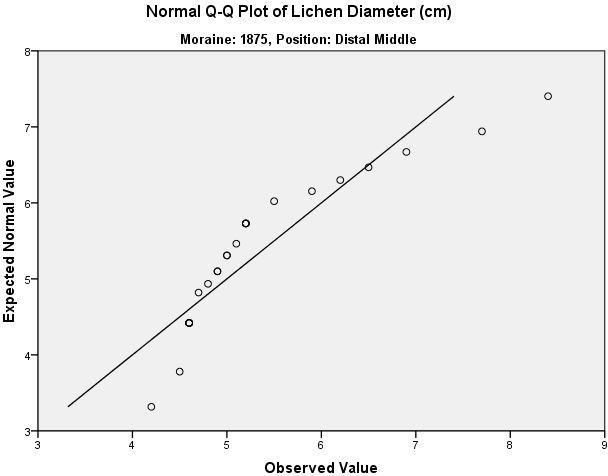
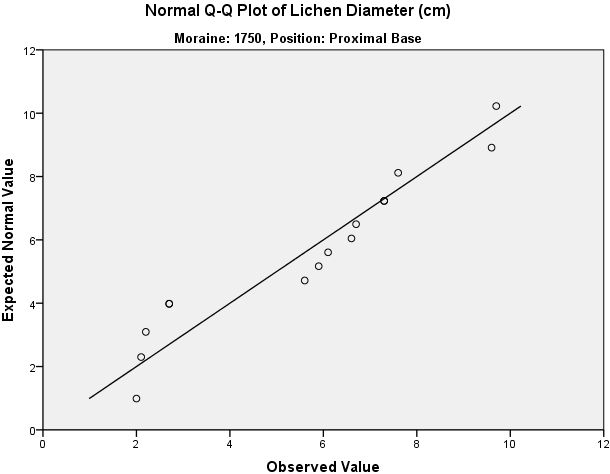
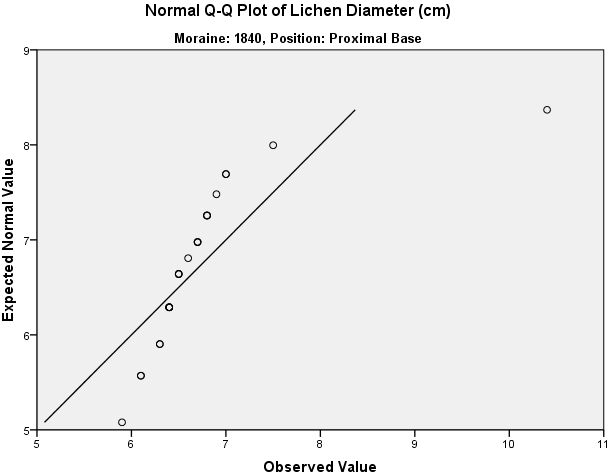
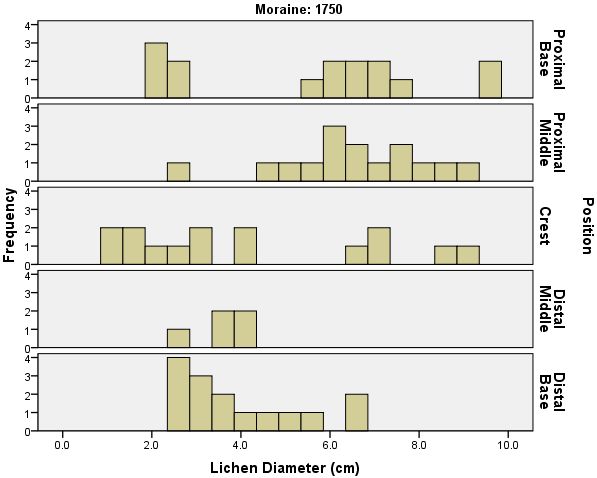
Notes
[1] Dee graduated from the University of Chester in June 2011 with a first class degree in Geography and Natural Hazard Management and is currently on a management trainee scheme with a large international retailer. In the future she would like to go back to higher education to complete a PhD.
References
Anderson, J. L. and J. L. Sollid (1971), 'Glacial Chronology and Glacier Geomorphology in the Marginal Zones of the Glaciers Midtdalsbreen and Nigardsbreen, south Norway', Norsk Geografisk Tidsskrift, 25, 1-38
André, M. F. (1986), 'Dating Slope Deposits and Estimating Rates of Rock Wall Retreat in Northwest Spitsbergen by Lichenometry', Geografiska Annàler, 68 (A), 65-75
Andrews, J. T. and P. J. Webber (1964), 'A Lichenometrical Study of the Northwestern Margin of the Barnes Ice Cap: A Geomorphological Technique' Geography Bulletin, 22, 80-104
Armstrong, R. A. (2002), 'The Effect of Rock Surface Aspect on Growth, Size Structure and Competition in the Lichen Rhizocarpon Geographicum', Environmental and Experimental Botany, 48, 187-94
Armstrong, R. (2004), 'Lichens, lichenometry and global warming', Microbiologist, 5, 32-35
Benedict, J. B. (1993), 'A 2000-year Lichen-Snowkill Chronology for the Colorado Front Range, USA', The Holocene, 3(1), 27-33
Beschel, R. E. (1973), 'Lichens as a Measure of the Age of Recent Moraines', Arctic and Alpine Research, 5 (4), 303-09
Bickerton, R. W. and J. A. Matthews (1992), 'On the Accuracy of Lichenometric Dates: an Assessment Based on the 'Little Ice Age' Moraine Sequence of Nigardsbreen, Southern Norway', The Holocene, 2 (3), 227-37
Bickerton, R. W. and J. A. Matthews (1993), ''Little Ice Age' Variations of Outlet Glaciers from the Jostedalsbreen Ice-Cap, Southern Norway: A Regional Lichenometric Dating Study of Ice-Marginal Moraine Sequences and Their Climatic Significance', Journal of Quaternary Science, 8, 45-66
Birkenmajer, K. (1981), 'Lichenometric Dating of Raised Moraine Beaches at Admiralty Bay, King George Island (South Shetland Islands, West Antarctica)', Bulletin de l'Académie Polonaise des Sciences, de la Terre, 27, 69-76
Bogen, J., B. Wold and G, Østrem (1989), 'Historic Glacier Variations in Scandinavia' in Oerlemans, J. (ed.), Glacier Fluctuations and Climatic Change, London: Kluwer Academic Publishers, pp. 109-28
Carroll, T. (1974), 'Relative Dating Techniques – A Late Quaternary Chronology, Arikaree Cirque, Colorado', Geology, 2, 321-25
Cook-Talbot, J. D. (1991), 'Sorted Circles, Relative-Age Dating and Paleoenvironmental Reconstruction in an Alpine Periglacial Environment, Eastern Jotunheim, Norway: Lichonometric and Weathering-Based Approaches', The Holocene, 1, 128-41
Curry, R. R. (1969), 'Holocene Climatic and Glacial History of the Central Sierra Nevada, California', Geological Society of America Special Paper, 123, 1-47
Erikstad, L. and J. L. Sollid (1986), 'Neoglaciation in South Norway Using Lichenometric Methods', Norsk Geografisk Tidsskrift, 40, 85-105
Gregory, K. J. (1976), 'Lichens and Determination of River Channel Capacity', Earth Surface Processes, 1, 273-85
Griffey, N. J. (1978), 'Lichen Growth on Supraglacial Debris and Its Implications for Lichenometric Studies', Journal of Glaciology, 20, 163-72
Haines-Young, R. H. (1983), 'Size Variation of Rhizocarpon on Moraine Slopes in Southern Norway', Arctic and Alpine Research, 15 (3), 295-305
Harvey, A. M., R. W. Alexander and P. A. James (1984), 'Lichens, Soil Development and the Age of Holocene Valley Floor Landforms Howgill Fells, Cumbria', Geografiska Annaler Series A, Physical Geography, 66 (4), 353-66
Innes, J. L. (1982), 'Debris Flow Activity in the Scottish Highlands', unpublished PhD thesis, University of Cambridge
Innes, J. L. (1984), 'The Optimal Sample Size in Lichenometric Studies', Arctic and Alpine Research, 15, 285-94
Innes, J. L. (1985), 'Short Communications – Lichenometric Dating of Debris-Flow Deposits on Alpine Colluvial Fans in Southwest Norway', Earth Surface Processes and Landforms, 10, 519-24
Innes, J. L. (1986), 'Influence of Sampling Design on Lichen Size Frequency Distributions and Its Effect on Derived Lichenometric Indices', Arctic and Alpine Research, 18, 201-08
Jones, R. L. and D. H. Keen (1993), Pleistocene Environments in the British Isles, London: Chapman and Hall
Lange, O. L., E. Kilian and H. Ziegler (1986), 'Water vapor uptake and photosynthesis of lichens: performance differences in species with green and blue-green algae as phycobionts', Oecologia, 71(1), 104-10
Loso, M. G. and D. F. Doak (2006), 'The biology behind lichenometric dating curves', Oecologia, 147, 223-29
Mahaney, W. C., J. R. Spence and R. H. Haines-Young (1985), 'Discussion of "Size Variation of Rhizocarpon on Moraine Slopes in Southern Norway" by R. H. Haines-Young', Arctic and Alpine Research, 17(2), 211-16
Matthews, J. A. (1973), 'Lichen Growth on Active Medial Moraine, Jotunheimen, Norway', Journal of Glaciology, 12, 305-13
Matthews, J. A. (1974), 'Families of Lichenometric Dating Curves from the Storbreen Gletschervorfeld, Jotunheimen, Norway', Norsk Geografisk Tidsskrift, 28, 215-35
Matthews, J. A. (1977), 'A Lichenometric Test of the 1750 End-Moraine Hypothesis: Storbreen Gletschervorfeld, southern Norway', Norsk Geografisk Tidsskrift, 31, 129-36
Matthews, J. A. (1994), 'Lichenometric dating: a review with particular reference to `Little Ice Age' moraines in southern Norway', in Beck, C. (ed.), Dating in exposed and surface contexts, Albuquerque: University of New Mexico Press, pp. 185-212
Met Office. (n.d.), Wales: Climate, http://www.metoffice.gov.uk/climate/uk/wl/, accessed 8 February 2011
Miller, G. H. (1973), 'Late Quaternary Glacial and Climatic History of Northern Cumberland Peninsula, East Baffin Island, N.W.T., Canada', Quaternary Research, 3, 561-83
Mottershead, D. N. (1980), 'Lichenometry – Some Recent Applications', in Cullingford, R. A., D. A. Davidson and J. Lewin (ed.), Timescales in Geomorphology, Chichester: Wiley, pp 95-108
Mottershead, D. N. and I. D. White (1972), 'The Lichenometric Dating of Glacier Recession, Tunsbergdal, Southern Norway', Geografiska Annàler. 54(A), 47-52
Nesje, A. and S. O. Dahl (1993), 'Lateglacial and Holocene Glacier Fluctuations and Climate Variations in Western Norway: A Review', Quaternary Science Reviews, 12, 255-61
Osborn, G. and J. Taylor (1975), 'Lichenometry on Calcareous Substrates in the Canadian Rockies', Quaternary Research, 5, 111-20
Pitman, G. T. K. (1973), 'A Lichenometrical Study of Snow Patch Variation in the Frederikshåb District, South-West Greenland, and Its Implications for Studies of Climatic and Glacial Fluctuations', Meddeleser om Grønland, 192, 1-31
Purvis, W (2000), Lichens, London: The Natural History Museum
Rapp, A. and R. Nyberg, (1981), 'Alpine debris flows in northern Scandinavia', Geografiska Annàler 63 (A), 183-247
Ryan, V (2004), The Vernier Calipier – Manual Version, http://www.technologystudent.com/equip1/vernier3.htm, accessed 16 November 2010
SeNorge.no(2011), Norwegian Meteorological Institute, http://senorge.no/, accessed 25 January 2011
Sjoberg, R. (1990), 'Measurement and Calibration of Weathering Processes and Lichenometric Investigations on a Wave Washed Moraine, Bådamalen, on the Upper Norrland Coast, Sweden', Geografiska Annàler, 72 (A), 319-27
Trenbirth, H. E. and J. A. Matthews (2010), 'Lichen growth rates on glacier forelands in southern Norway: preliminary results from a 25-year monitoring programme', Geografiska Annaler: Series A, Physical Geography, 92 (1), 19-39
Webber, P. J. and J. T. Andrews (1973), 'Lichenometry: A Commentary', Arctic and Alpine Research, 5, 295-302
Worsley, P. (1990), 'Lichenometry', In Goudie, A., M. Anderson, T. Burt, J. Lewin, K. Richards, B. Whalley and P. Worsley (eds) (2nded.), Geomorphological Techniques, New York: Routledge, pp. 422-28
To cite this paper please use the following details: Johnson, D., (2011), 'An Investigation into Lichen Growth on Terminal Moraines on the Glacial Foreland of Nigardsbreen, South Norway', Reinvention: a Journal of Undergraduate Research, British Conference of Undergraduate Research 2011 Special Issue, http://www.warwick.ac.uk/go/reinventionjournal/issues/bcur2011specialissue/johnson. Date accessed [insert date]. If you cite this article or use it in any teaching or other related activities please let us know by e-mailing us at Reinventionjournal at warwick dot ac dot uk.
